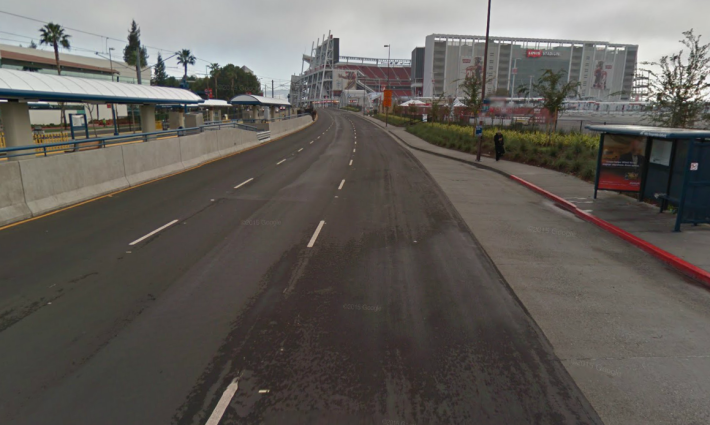Santa Clara OKs Road Diet, Bike Lanes on “Ludicrously Overbuilt” Tasman Dr.
1:32 PM PDT on April 29, 2015

Santa Clara's City Council unanimously approved a road diet last week on the city's 1.5-mile section of Tasman Drive. Tasman, east of Great America Parkway, will have two of its six traffic lanes re-purposed for wide buffered bike lanes and permanent median fences to protect Valley Transportation Authority (VTA)'s light-rail tracks. West of Great American Parkway, where Tasman was has four lanes, only striped bike lanes would be added.
Tasman is "ludicrously overbuilt," Cyclelicious author Richard Masoner wrote in a blog post the day before the vote. Masoner wrote at the time that the council seemed "reluctant" to approve the project at a meeting in late March. "There is literally no downside for this project no matter which mode of transportation you use, so what’s the problem?," he wrote.
The council approved the project unanimously and without discussion last Tuesday.
At the March meeting, Council Member Patrick Kolstad asked if transportation planners would consider removing the Tasman bike lanes in 10 years if there are more cars to move. Council Member Lisa Gillmor claimed the road diet is "going to be a nightmare during traffic hour," pointing to Pruneridge Avenue, where one of four traffic lanes was removed to add bike lanes in late 2011.

But according to a 2013 city traffic study [PDF], the Pruneridge road diet cut collisions in half, more than tripled weekday bicycle traffic, and cut weekday car traffic by 5 percent. The average delay for rush-hour drivers remained unchanged at the Pomeroy Avenue intersection (at just eight seconds).
Regardless, "Citizen complaints about perceived delays poured into City Hall," Masoner wrote.
Council Member Jerry Marsalli also said he was concerned that four lanes wouldn't be enough for the potential car traffic generated by an 8 million square feet mixed-use mega-development planned for Santa Clara's municipal golf course, and the planned redevelopment of a sprawling industrial area along Tasman and Lafayette Street into high-density housing. "Are we going to be able to handle that increase in traffic with this lane reduction?," he asked. "I just see it going up."
City transportation planners assured the council that four lanes on Tasman would still provide more than twice the capacity needed for the 1,300 vehicles per hour that currently travel eastbound during the evening commute. They would even accommodate the car traffic expected from the next 20 years of planned development, according to a 2013 city study [PDF].
Still, Santa Clara traffic engineer Dennis Ng told the council that more cars could be moved with better coordination of traffic signals on Tasman. As a "side-benefit" of the lane reduction, double left-turn lanes could also be installed at the intersections of Convention Center and Centennial Boulevard.
In addition to bike lanes, converting the six-lane section of Tasman to match the rest of the four-lane street would allow room for permanent median fences to protect VTA light-rail trains from disruptions. During games at Levi's Stadium, a stretch of Tasman is closed to car traffic, allowing crowds to roam the road.
"During the first year of events at the Stadium, temporary fencing along the tracks was occasionally knocked over onto the tracks," creating a safety hazard for pedestrians and light rail passengers, Public Works Director Rajeev Batra wrote in a City Council report [PDF].
Once the engineering design for Tasman is finished, the bike lanes and permanent fencing is expected to be installed this summer.
Stay in touch
Sign up for our free newsletter
More from Streetsblog San Francisco
Commentary: Make Bay Area Transit Seamless as Condition of New Funding
SFMTA Starts West Portal Outreach
Agency presents plans to block traffic from crossing in front of the train station




